Philips OLED 809 is quite a versatile television that appeals to a wide range of consumers. Its standout feature among all the TV models on the market is the multicoloured Ambilight backlighting. It often allows for even greater immersion and engagement in the world of film. What is most important in televisions—contrast, black levels, and colour reproduction—are all at a high standard, which is something that will always impress in OLED TVs. The tested television, while performing quite well in our tests, does have some notable drawbacks. These include the quality of tonal transitions and the jumpy operation of the dynamic tone mapping feature. In some cases, these can be slightly irritating to sensitive eyes. However, Philips OLED 809 performs really well in other aspects, particularly in two areas: gaming performance and motion smoothing. The former stands out significantly, as each of the implemented features operates without the slightest hiccup, allowing for an even more immersive gaming experience. As for motion smoothness, it matches the high level of support for gaming. Thanks to two sliders, whose effects are noticeable at every position, every user is able to find the best level of smoothing for themselves. One cannot overlook the Google TV system, which operates very smoothly and during the tests, there were no instances of any "stuttering".
- Matching (Score)
- Our verdict
- TV appearance
- Where to buy
- Contrast and black detail
- HDR effect quality
- Factory color reproduction
- Color reproduction after calibration
- Smoothness of tonal transitions
- Image scaling and smoothness of tonal transitions
- Blur and motion smoothness
- Console compatibility and gaming features
- Input lag
- Compatibility with PC
- Viewing angles
- TV efficiency during daytime
- Details about the matrix
- TV features
- Apps
- Playing files from USB
- Sound
Philips OLED809/819 vs Samsung S85F OLED
Direct compare
OLED809 / OLED819 / AMIBLIGHT TV
S85F / FAE / FAU
Available screen sizes: 55”

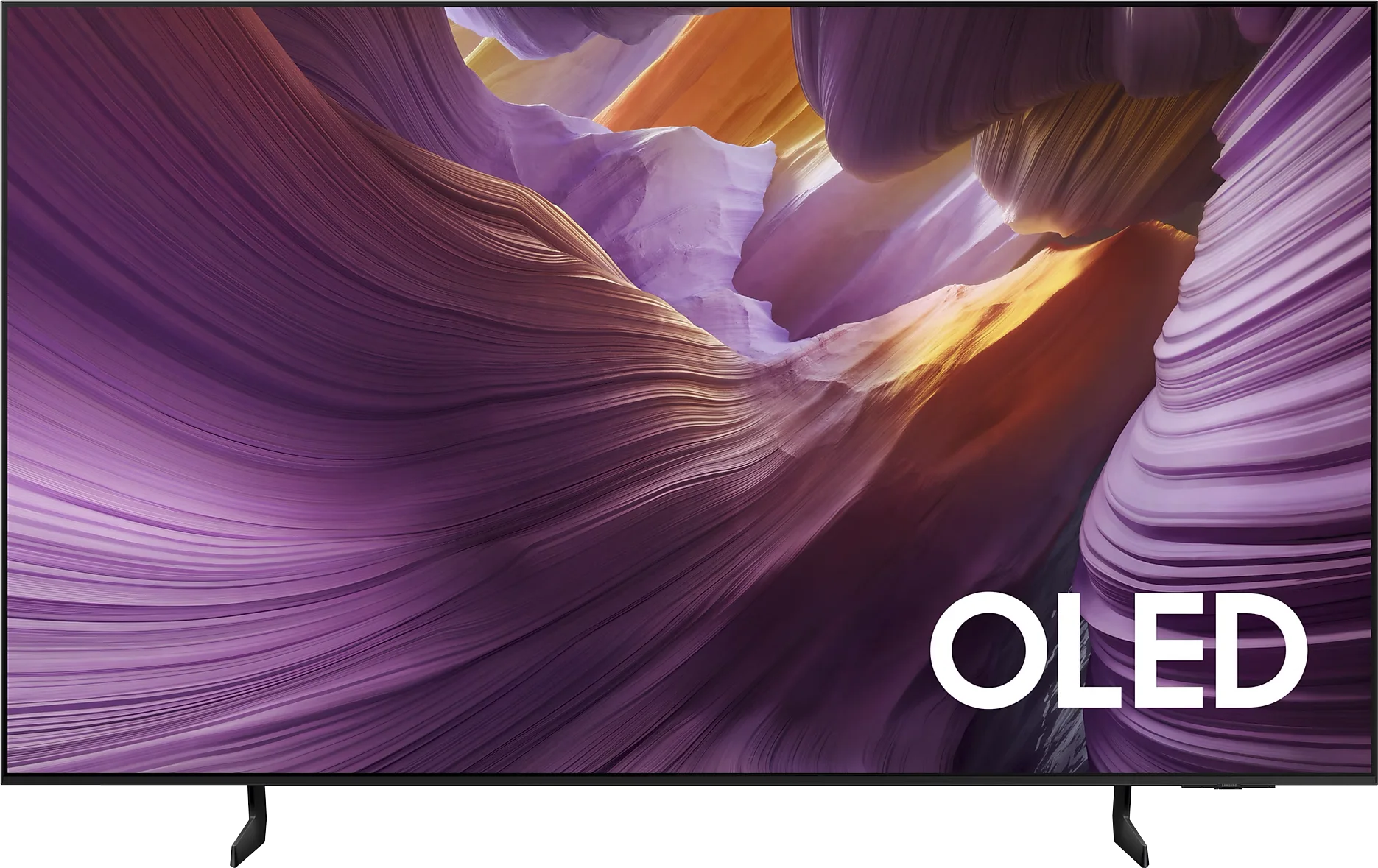
Panel type: WRGB OLED
Resolution: 3840x2160
System: Google TV
Model year: 2024
Complete the survey to find out the result

Panel type: QD-OLED
Resolution: 3840x2160
System: Tizen
Model year: 2025
Complete the survey to find out the result

Overall rating
7.6
8.0
Movies and series in UHD quality
7.3
8.3
Classic TV, YouTube
7.8
9.0
Sports broadcasts (TV and apps)
8.2
8.8
Gaming on console
9.2
9.3
TV as a computer monitor
6.4
7.6
Watching in bright light
5.5
5.1
Utility functions
7.8
7.2
Apps
9.6
8.7
Sound quality
7.1
7.2
Complete the survey to find out what fits your preferences
Advantages
Extensive Google TV system with good app support
Very good collaboration with the console
Good image smoothness and an extensive system for improving it
Multicoloured Ambilight backlighting
Outstanding black levels and contrast
Amazing colour palette coverage thanks to the QD-OLED panel
Great picture quality in SDR and HDR content
High colour accuracy after calibration
Very good motion smoothness – 120 Hz OLED panel
Rich set of features for gamers: VRR, Game Bar, low input lag
4 HDMI 2.1 ports with full 48 Gbps bandwidth
Advanced and smoothly operating Tizen system
Solar Remote with multiple capabilities
Disadvantages
Poor factory colour reproduction (can be fixed through calibration)
Strongly contrasting tonal transitions
Average legibility of fonts when connected to a computer
No USB recording function and PiP
No Dolby Vision
Slight cherry black under very strong external light (not visible when watching in cinema conditions)
No HGiG function*
* This function disappeared with software update 1110.7 – we are monitoring this situation closely.
Our verdict
The Samsung S85F with a QD-OLED panel is capable of surprising – and in a very positive way. Even before the tests, we did not think that in the case of TVs often referred to in the context of "panel lotteries", one could come across something that would benefit the user. Yet, in this case, particularly with the 55-inch version, it has fully succeeded. The QD-OLED panel, as expected from organic technology, offers near-perfect blacks and contrast in cinematic conditions. However, the difference lies in the way the colours are rendered – here it is simply exceptional. The colour gamut coverage is impressive, and after a slight calibration, the colours become almost exemplary. Motion fluidity is also at a very high level. The 120 Hz panel handles both sports and action films excellently. And if someone plans to connect a console to the S85F, they will receive a full set of advantages: low input lag, variable refresh rate, Game Bar, and full HDMI 2.1 support. In everyday use, we were supported by the Tizen system – closed, but extremely polished. It responds quickly, offers a rich selection of apps, and features like AirPlay and voice control make it hard to find anything more complete in this category. True, the S85F is not without its flaws. However, the balance of pros and cons is exceptionally favourable here. One could even get the impression that it is one of the best TVs in its price segment.
TV appearance



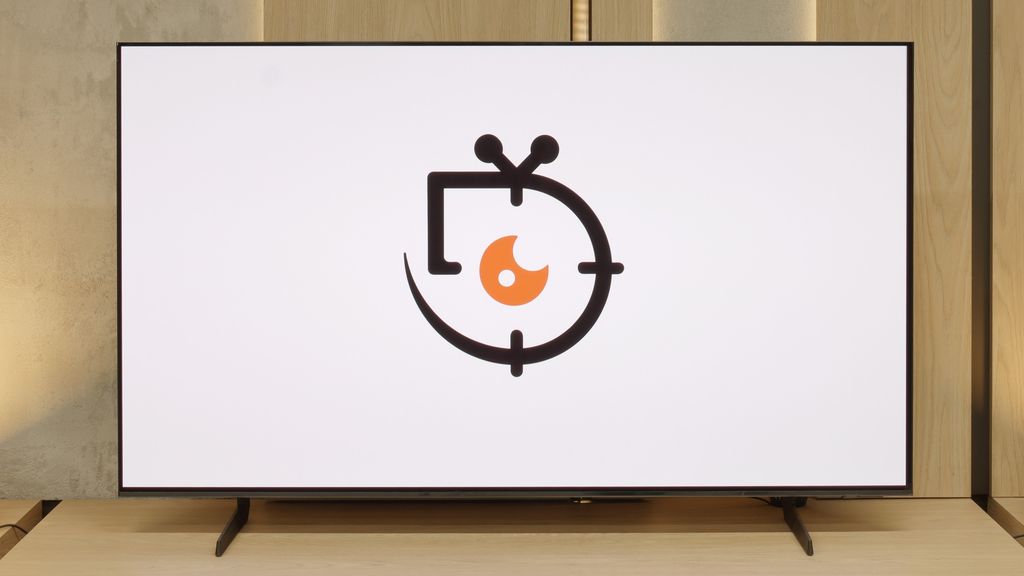

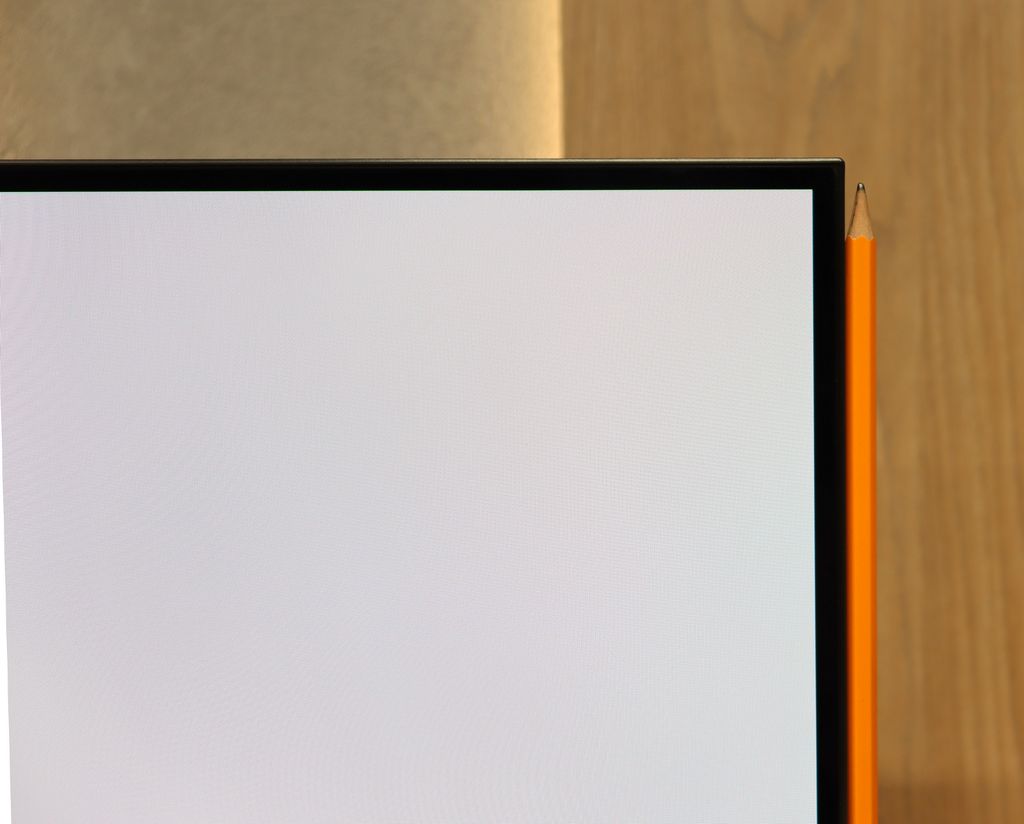
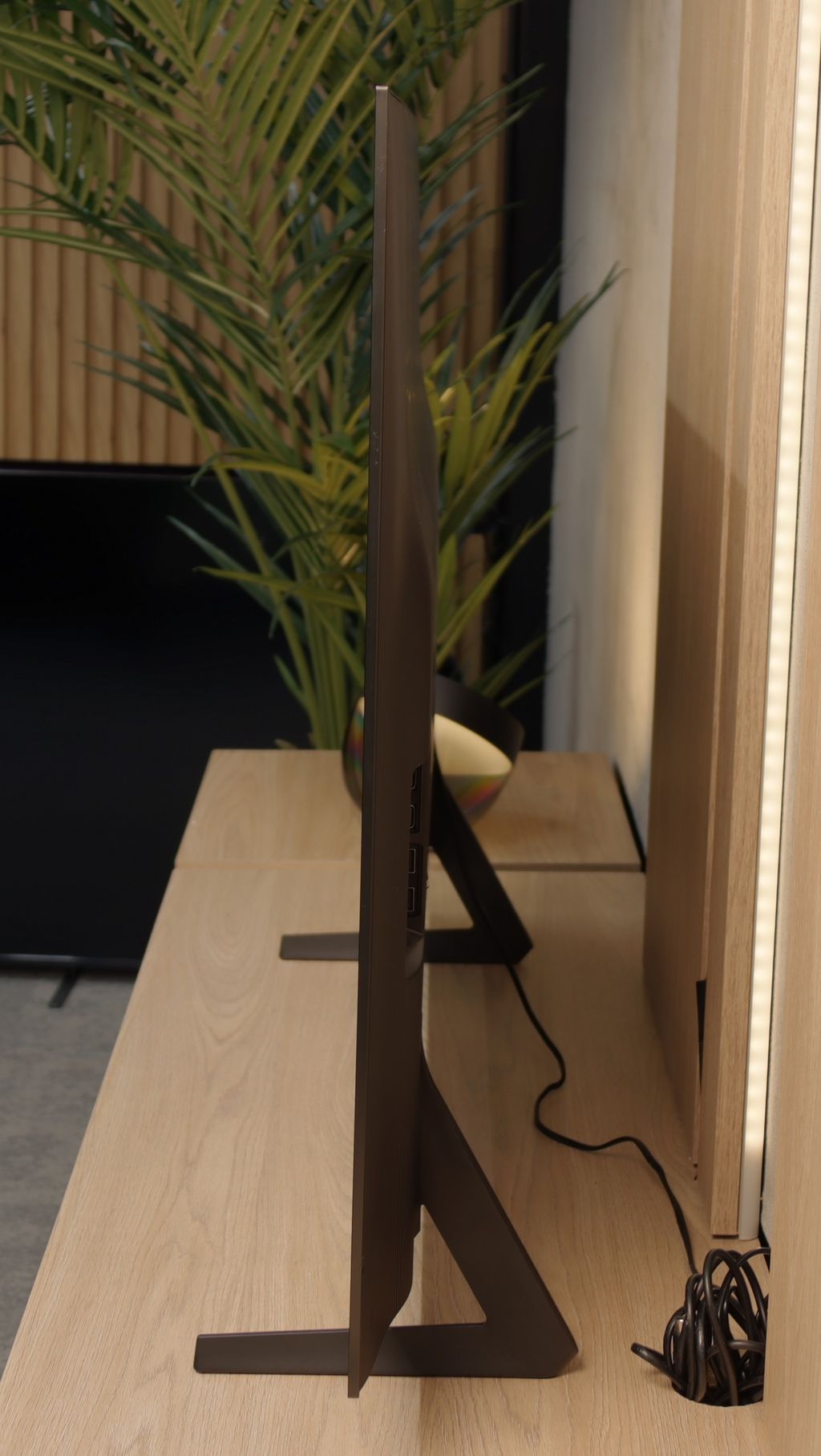
Contrast and black detail
10/10
10/10
Contrast:

Result
∞:1

Result
∞:1

Result
∞:1

Result
∞:1

Result
∞:1

Result
∞:1

Result
∞:1

Result
∞:1

Result
∞:1

Result
∞:1
Halo effect and black detail visibility:

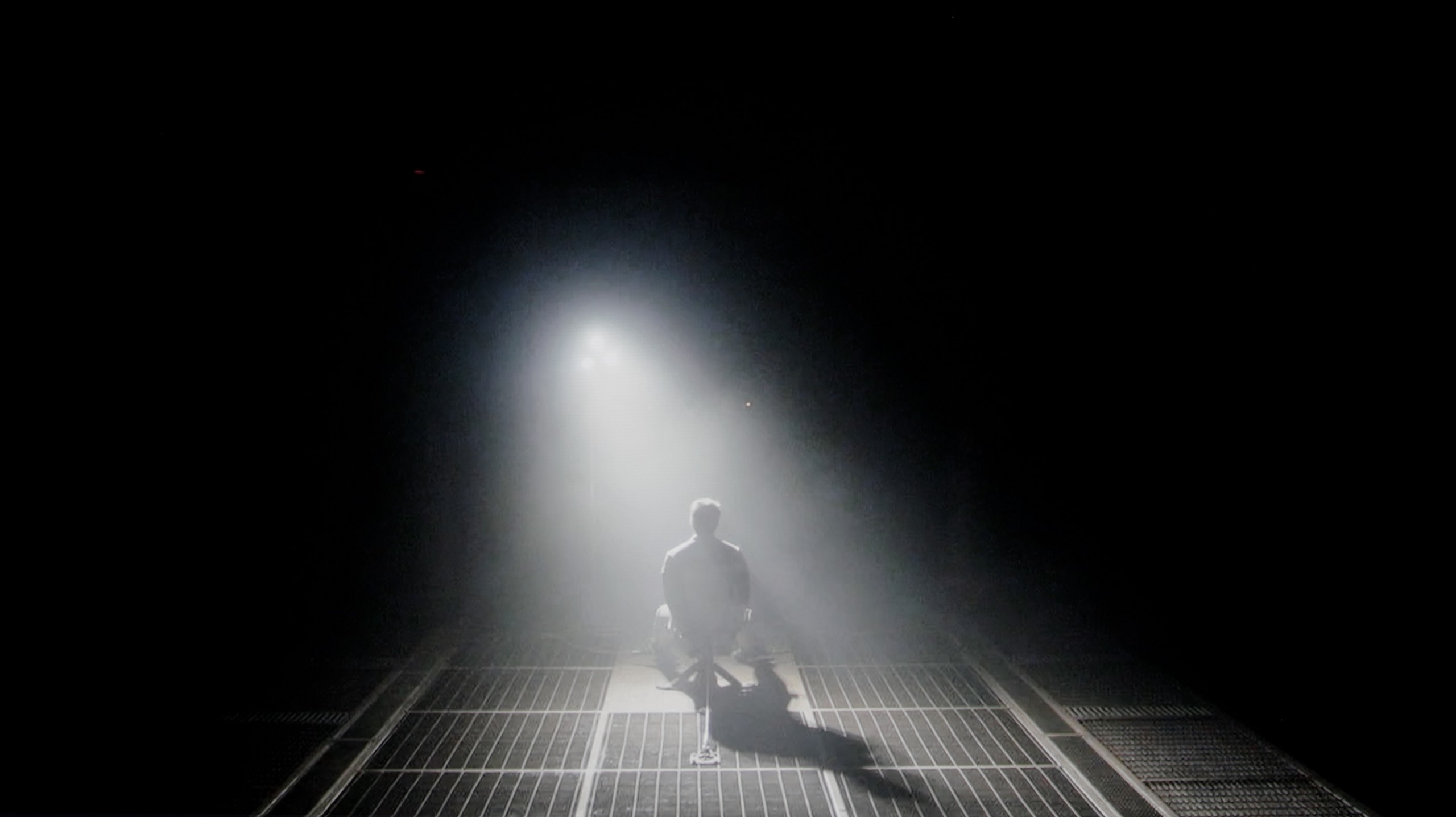
Philips OLED 809, as the name suggests, uses an organic matrix. Like the vast majority of manufacturers, it comes from the LG Displays factory, which is not surprising, as other leading manufacturers, such as Sony and Panasonic, also use them. The application of this type of panel allows for achieving an ideal result in the contrast and black tests. Thanks to such results, the image is incredibly plastic and free from any blooming effect of bright texts on a dark background, which has become an inherent feature of televisions with local dimming. This is enabled by the very construction of the panel, which is not made up of many layers of filters, but of organic conductive polymers, controlled by electrical impulses. Therefore, if we want to achieve black, the pixel turns off to a value of 0, rather than being covered up. The lights present in the test image are perfectly separated from each other, which is extremely difficult, and often impossible for LCD televisions. One of the strongest points of Philips OLED 809 is its ability to render contrasts. Philips OLED809 test showed that the television handles the separation of bright elements, such as headlights, from the dark background excellently.
Samsung S85F in the 55-inch version has something special – it features a QD-OLED panel. This might sound quite surprising, but that's the fact, at least in Poland. So the question arises: is the difference compared to last year's S85D with a WOLED panel even noticeable? Yes, although in this specific test – black levels and contrast – it practically makes no difference.
Regardless of the scene, the S85F presents infinite contrast and perfect blacks that we expect from any OLED. These results can impress even the most demanding film enthusiasts. It's worth remembering that only TVs with organic panels can provide such deep blacks – and it doesn't matter whether it's WOLED or QD-OLED. So if you dream of a screen that can 'turn off' the light in a scene just as effectively as a boutique cinema in a dark room, the S85F is one of those TVs.
HDR effect quality
6.9/10
6.2/10
Luminance measurements in HDR:

Result
921 nit

Result
970 nit

Result
1039 nit

Result
1022 nit

Result
425 nit

Result
666 nit

Result
703 nit

Result
742 nit

Result
732 nit

Result
433 nit
Scene from the movie “Pan” (about 2800 nits)


Scene from the movie “Billy Lynn” (about 1100 nits)


Static HDR10


Dynamic: Dolby Vision
Dynamic: HDR10+


HDR luminance chart:
Samsung S85F OLED
Luminancja HDR
Luminance of RGB colors
Philips OLED809/819
Luminancja HDR
Luminance of RGB colors
Philips OLED 809 delivers a more than satisfactory HDR effect. The television is capable of generating luminance exceeding 900 nits in almost every scene, and sometimes even over 1000. This result allows for a full experience of materials with a wide tonal range. The only moment when Philips OLED 809 cannot generate higher brightness is in a scene from the film "The Meg," which features a large amount of bright white across much of the screen. However, it cannot be said that this is a weak result, as it represents a significant improvement over its predecessor. Overall, such values for OLED panels produced by LG Display, which do not have MLA technology, are very, very good. Combined with high coverage of the DCI-P3 colour gamut, they allow for an HDR experience in a remarkable dimension. Philips OLED 809 test indicated that this television supports popular HDR formats such as Dolby Vision and HDR10+.
As an OLED, the Samsung S85F can shine – literally. In favourable conditions, it can generate brightness exceeding 750 nits. This is significant because most films are created with displays aiming for around 1000 nits. In practice, this means that in scenes with moderately large, bright elements, the picture can look absolutely stunning. However, it's not always so rosy. When an enormous amount of light appears on the screen – whether it's an expansive, bright background or an entire frame filled with white – the S85F must tone it down. Brightness can drop by even four times in such scenes. This limitation is well-known to anyone familiar with OLEDs in this price segment, so we don't view it as a particular fail. However, something that deserves praise is what sets this model apart from the competition – colour gamut coverage. Thanks to the QD-OLED panel, our colour meter indicated values exceeding 100% coverage of DCI-P3 and an impressive 86% for the ultra-wide BT.2020 palette. Such results are hard to find even in televisions that cost several times more.
Factory color reproduction
5.1/10
5.5/10


Factory Mode
After calibration
The best factory mode in which we conducted all our tests was "Filmmaker", which is now quite standard in televisions from this manufacturer. However, let's take a look at its characteristics before we start the calibration process. The first aspect we will examine is white balance, as despite being inconspicuous, it determines whether the image will be free from any tints. The graph clearly shows that in both SDR and HDR content, two colours dominated: red and green, which caused a strong yellow tint that was pervasive throughout the image. This is perfectly visible on the "ColourChecker" palette, where all colours shifted towards their warmer counterparts. The second thing we will scrutinise are, in our opinion, the two most important graphs in the context of image quality assessment: gamma and the EOTF curve. Both are intended to maintain appropriate brightness and contrast. The first describes the level of brightness in SDR materials, while the second depicts the rate of luminance increase. Analysing the first one, we can see that it has been remarkably lowered compared to the reference value indicated by the orange line. This situation resulted primarily in a sharp increase in brightness and a significant decrease in contrast, reminiscent of what one would expect from OLED televisions. The EOTF curve showed greater "caution" and only slightly brightened the entire image to 50% of the maximum brightness.
Samsung, as befits a manufacturer with ambitions, has equipped the S85F with a mode called Filmmaker. Its task is simple: to make the colours on the newly purchased television as faithful as possible to what the director intended to show us. Sounds great… but, as is often the case, a theory that sounds wonderful doesn’t always translate into perfect practice.
In the tested unit, it quickly became apparent that the image – due to an excess of blue and red – looked as if someone had gone a bit overboard with the saturation. As a result, there were quite significant colour errors, particularly in 4K content. On top of that, there was an issue with brightness – the S85F could brighten most scenes more than it should, stripping them of the intended mood.
Fortunately, Samsung televisions, including the S85F, offer an impressive number of settings for advanced calibrators. This means that we could see what this panel is really capable of when it gets into the right hands.
Color reproduction after calibration
9/10
9.3/10




Philips, like most leading manufacturers, has been providing advanced tools for the calibration process for years. Here, we find 2- and 20-point grey scale adjustments as well as an advanced CMS (Color Management System). As you can see, this has brought extremely beneficial results and fundamentally changed the perceived image. Practically every one of the elements mentioned above has undergone a transformation and has been returned to its natural state. This is particularly evident on the "ColourChecker" palette, where the measured samples are harmoniously in their places. It must be said that the white balance has turned out exceptionally well, allowing us to enjoy a clean image free from any tint in both SDR and HDR materials. The biggest issue with OLED809, which is gamma, has been properly modelled and only occasionally shows minor errors that won't affect the overall picture. The EOTF curve, on the other hand, has been stripped of that slight brightening and now presents itself almost referentially.
Thanks to the huge number of settings in the menu, we managed to bring the S85F almost to perfection. White balance in SDR content? Literally perfect – deviations do not exceed a value of "1". So we can confidently say that in materials with not too high dynamics, we have an image that's close to reference.
In HDR content, minor issues appeared, but they don't have much significance in practice – most errors fall below the threshold of perception, which is a value of "3". We also managed to tame the S85F when it comes to brightness management – the EOTF curve, even in films, holds nearly perfect straight line. This is one of those cases where after calibration, you can comfortably forget about the settings and simply watch movies and series at the highest level.
Smoothness of tonal transitions
2.4/10
7.9/10












Equally important as colours, black and contrast in the context of image quality assessment, is its purity. The quality of tonal transitions can also be included in this category. How many of you have experienced the “banding” effect on your older screens? It is extremely annoying and often effectively hinders immersion in the series or film being watched. Philips OLED 809 unfortunately has some of those issues that are better left unmentioned. However, out of editorial duty, they deserve to be examined and assessed, which will be quite simple given their lack of complexity. As you can see, practically every scene showed a lack of fluidity between colours. And just like in the movie “Kingsman,” this is still acceptable, but in other productions, you really cannot leave a dry thread on them, especially when looking at “The Green Knight.” There, the dense fog has practically been replaced by horizontal bands and indistinct geometric shapes. There are televisions that can manage tonal transitions perfectly, but unfortunately, Philips OLED 809 doesn't belong to that group. During testing, we could see the banding effect, particularly in demanding scenes, which negatively impacts the viewing experience. Philips OLED 809 test indicates that even the options for removing posterization are not sufficiently helpful, which can be considered a serious flaw.
Thanks to the QD-OLED panel, colour blending on the S85F is really very good. It's particularly worth noting how it performs in the darkest, most demanding scenes – where most TVs start to struggle, this model operates almost perfectly.
Interestingly, a slight stumble can be noticed in those easier, brighter shots. There is minimal colour banding, but it's so subtle that it's hard to believe it would genuinely bother anyone during viewing.
Image scaling and smoothness of tonal transitions
5.5/10
7/10
Smooth transition function

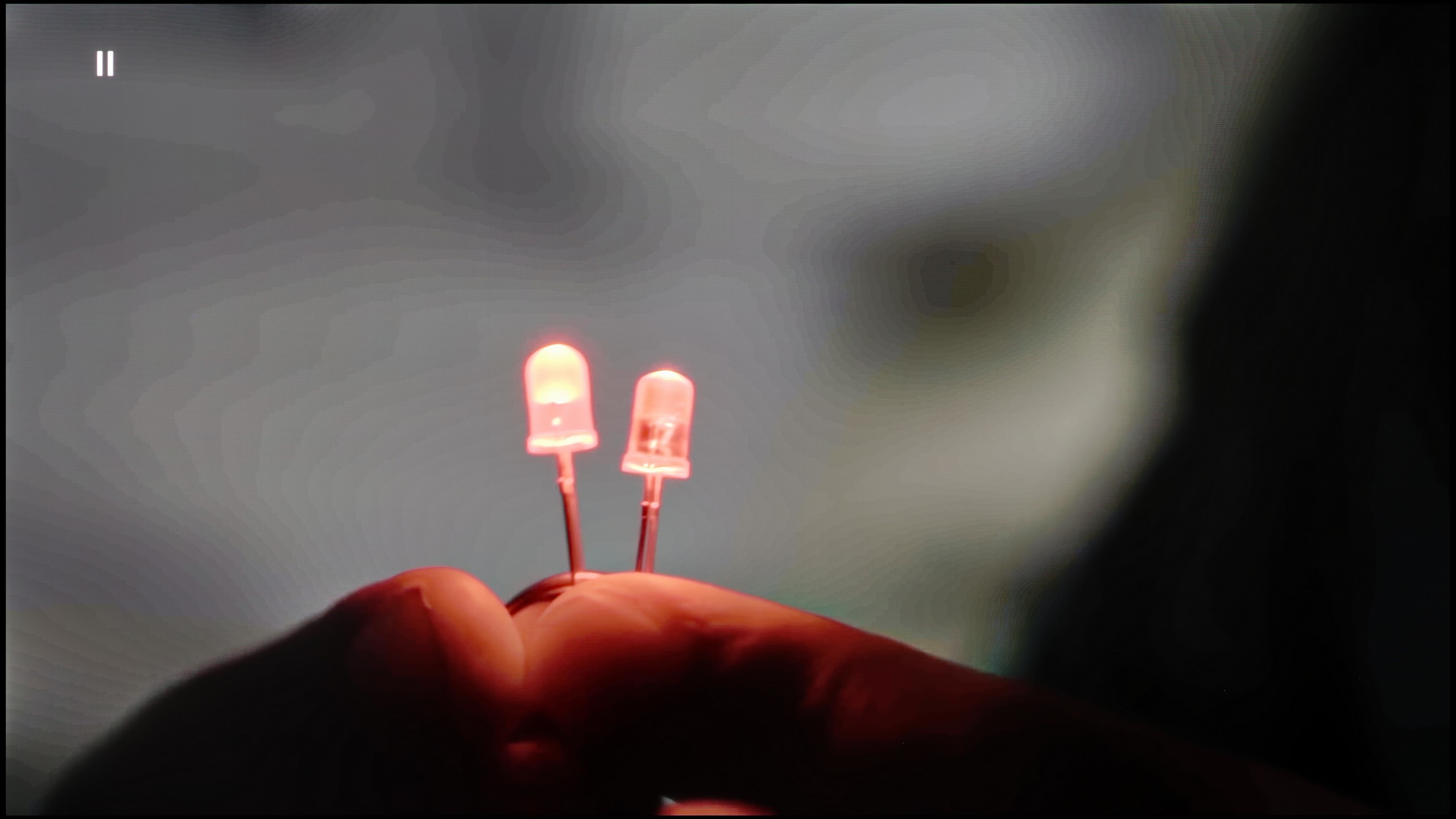
Image without overscan on the SD signal


Philips OLED 809 didn't perform too well in the test for the smoothness of tonal transitions. Moving on to the part of the test where we assess the behaviour of the TV's algorithms, we will again check the function responsible for removing posterisation. In fact, such a function exists in the menu and has several options available. As you can see in the photo on the left, although its presence has been confirmed by us, it is not useful. Only at the highest setting does it effectively remove disruptions, but it blurs the entire image in the process. Therefore, it is completely unusable.
Time and again, you and we find ourselves watching materials of lower quality. In this case, the quality of the image upscaling algorithms can have a salvaging effect. We must admit that those implemented in OLED 809 work quite efficiently and improve the image quality without visible artefacts. You can only notice slight edge blurring, but it is unlikely to be noticeable during normal viewing.
The tone transition smoothing function in the S85F works really effectively – it can completely eliminate the problem of visible banding in very poor quality material, such as from YouTube. Unfortunately, even the lowest level of this option comes with compromises. The noise reduction is so aggressive that it can smooth out film grain, which many of us consider to be an element of the cinematic atmosphere. At the “Standard” level, we didn’t notice this function removing anything significant from the image, so we can recommend this setting. On the other hand, the “High” level is a different story – it can smooth out not just noise, but also small, desirable details like, for example, the texture of objects.
When it comes to image scaling, the S85F performs very well. The material looks sharp, and the only slight imperfection is the barely noticeable aliasing of edges. And there’s the ongoing issue with Samsung televisions – overscan. This can cause some scenes to be slightly cropped, which is worth noting when watching very old content.
Blur and motion smoothness
8.5/10
8.5/10

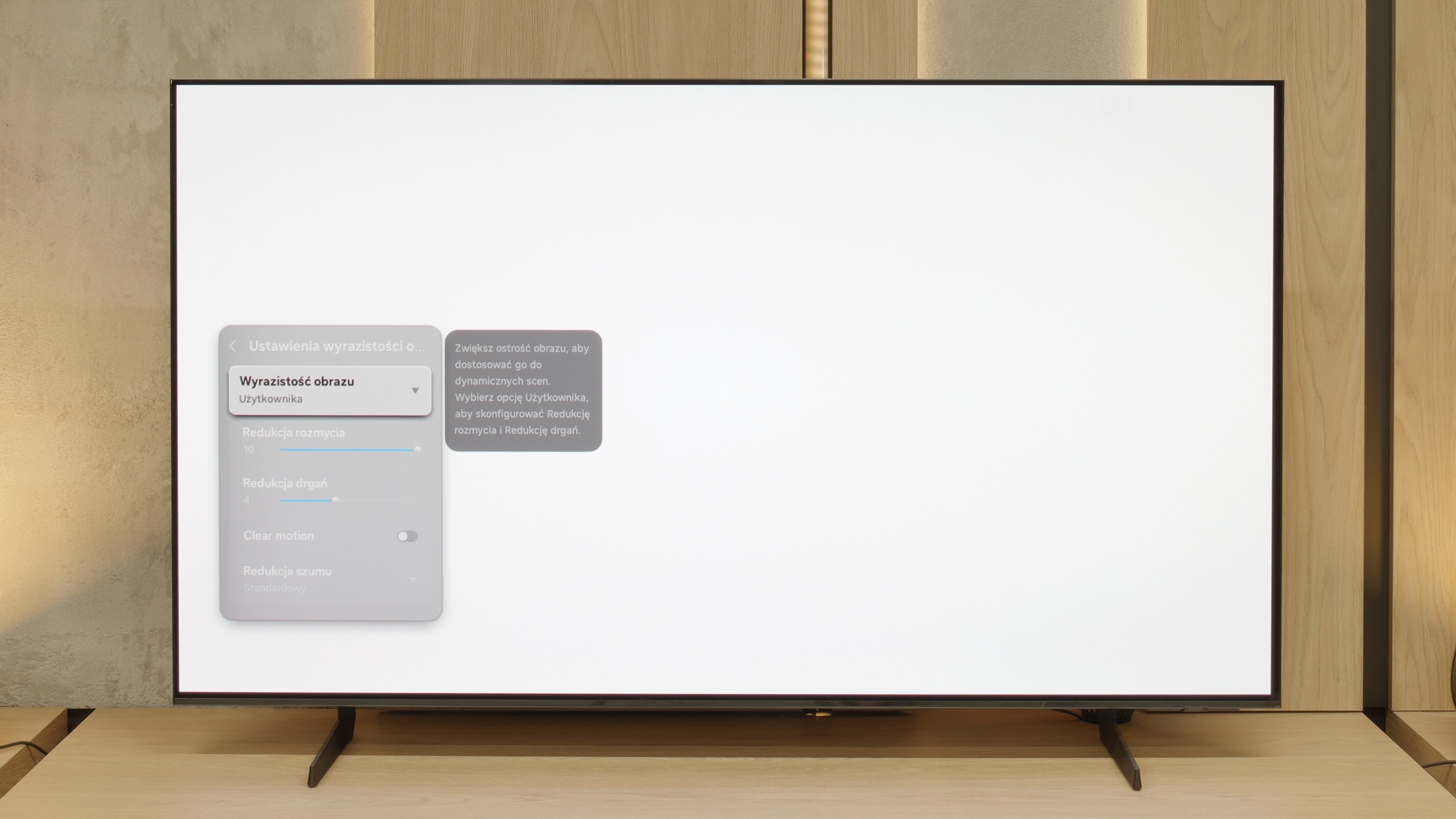
Blur (native resolution, maximum refresh rate):






Blur (BFI function enabled):
Image flickers in this mode



Smużenie ():
Smużenie (4K@60Hz Game Motion Plus):

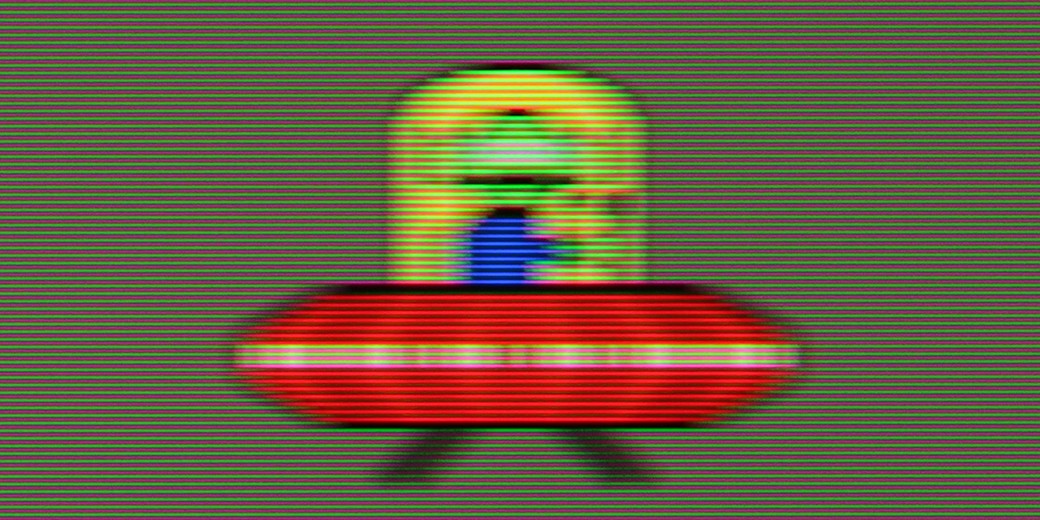
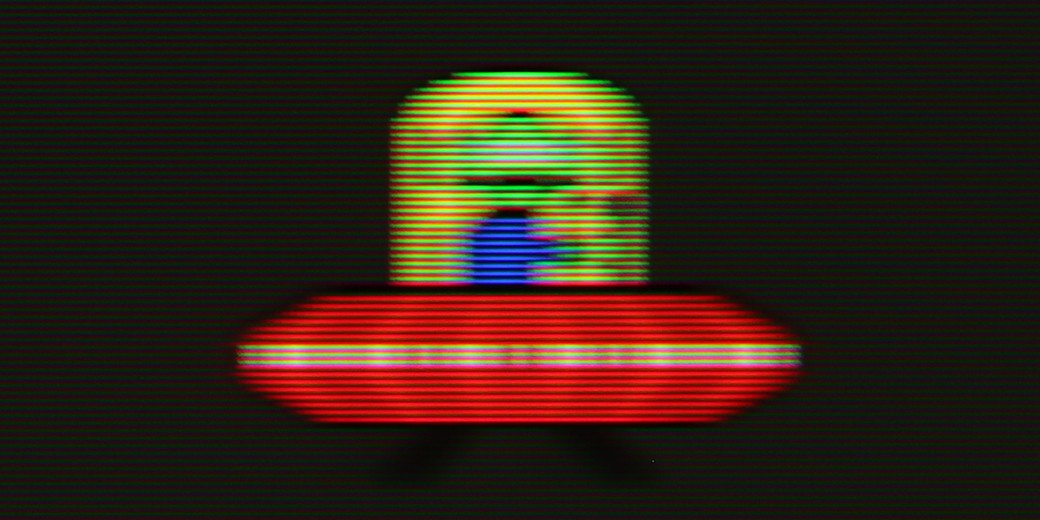
The maximum refresh rate we can set on the tested television is 144 Hz. This value can be achieved by connecting it to a really powerful PC. In the case of consoles or television, everything remains the same. For those who require high movement fluidity or dislike the characteristic judder of films recorded at 24 fps, the manufacturer has prepared a fairly advanced motion smoothing system. In the dedicated tab, we will find the “Smoothness” slider responsible for eliminating judder and “Blur Reduction”, which helps increase the sharpness of dynamic elements. The function works very well and granularly, meaning each of the settings has a real impact on the perception of motion. We also mention that it works at a refresh rate of 120 Hz, as it operates on the multiples of film or television materials. Thanks to such an extensive set, every user will find their happy medium. In the photo, we present our choice, which is slight smoothing without the soap opera effect.
Motion is influenced not only by the settings on the television but also by the response time of the panel itself. OLED televisions feature the best response time on the market, which in the case of 809 is about 0.1 ms. There are no IPS/ADS or even VA panels that significantly come close to the results of organic panels.
S85F is an incredibly fast television – and that’s not just empty hype. Thanks to the 120 Hz OLED panel, dynamic scenes, whether in games or while watching a live match, look just as they should – smooth, sharp, and without the feeling that something is "slipping" out of frame. The lightning-fast pixel response time, typical of OLEDs, plays a big role here. Transitions between frames are virtually instantaneous, and the image remains clear even during the fastest camera movements. A ball flying across half the field? A car speeding in a chase scene? Everything here is clear and free of the typical "trail" associated with LCDs.
This is exactly what we expect from a good OLED – zero compromises when it comes to motion smoothness. The S85F gives the impression that regardless of the pace of action, we can focus on what’s happening on the screen, rather than on the imperfections of the image.
Console compatibility and gaming features
10/10
8.2/10
- ALLM
- VRR
- VRR range40 - 144Hz48 - 120Hz
- Dolby Vision Game Mode
- Correct implementation of HGIG
- 1080p@120Hz
- 1440p@120Hz
- 4K@120Hz
- Game bar

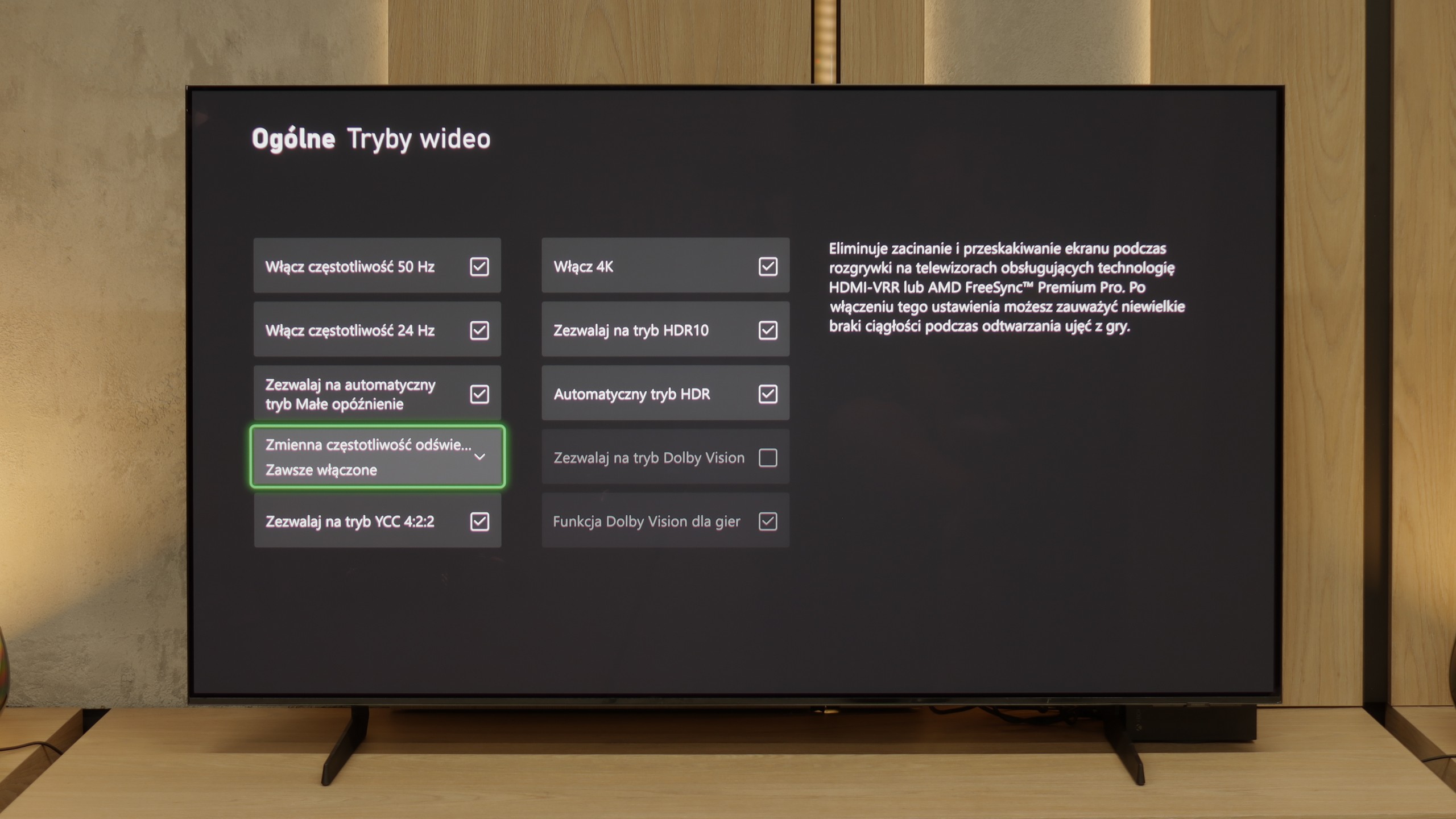

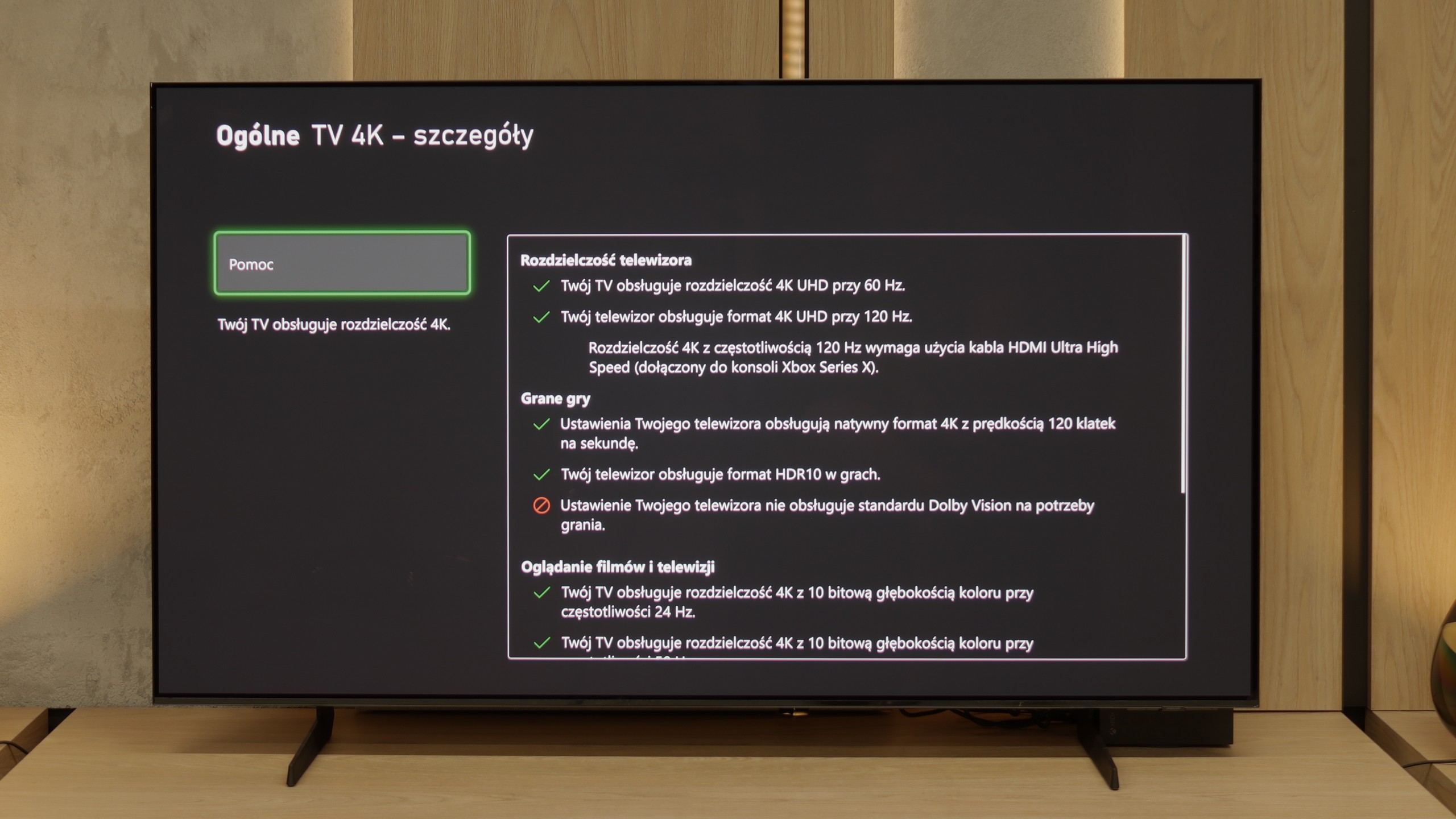

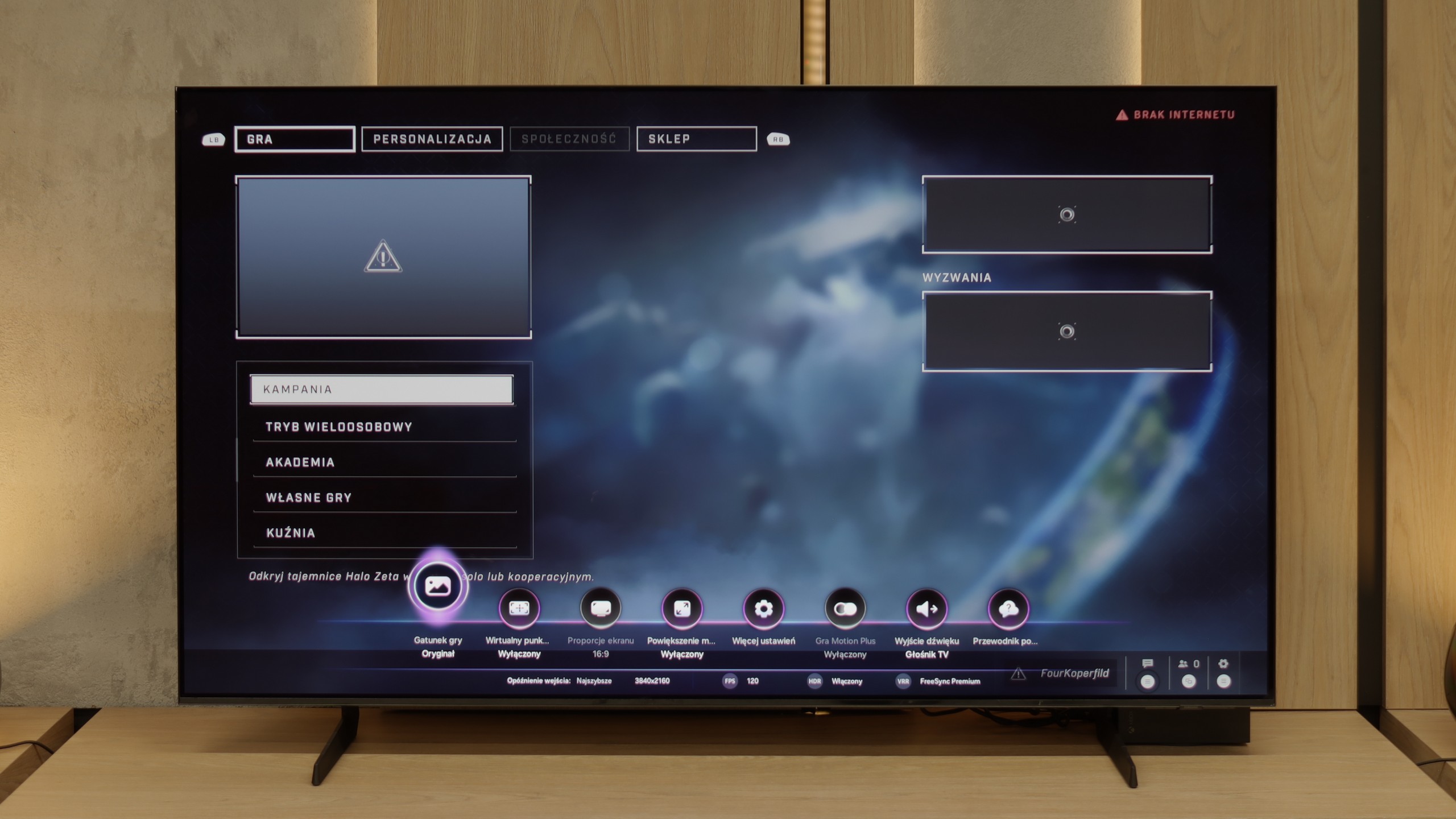

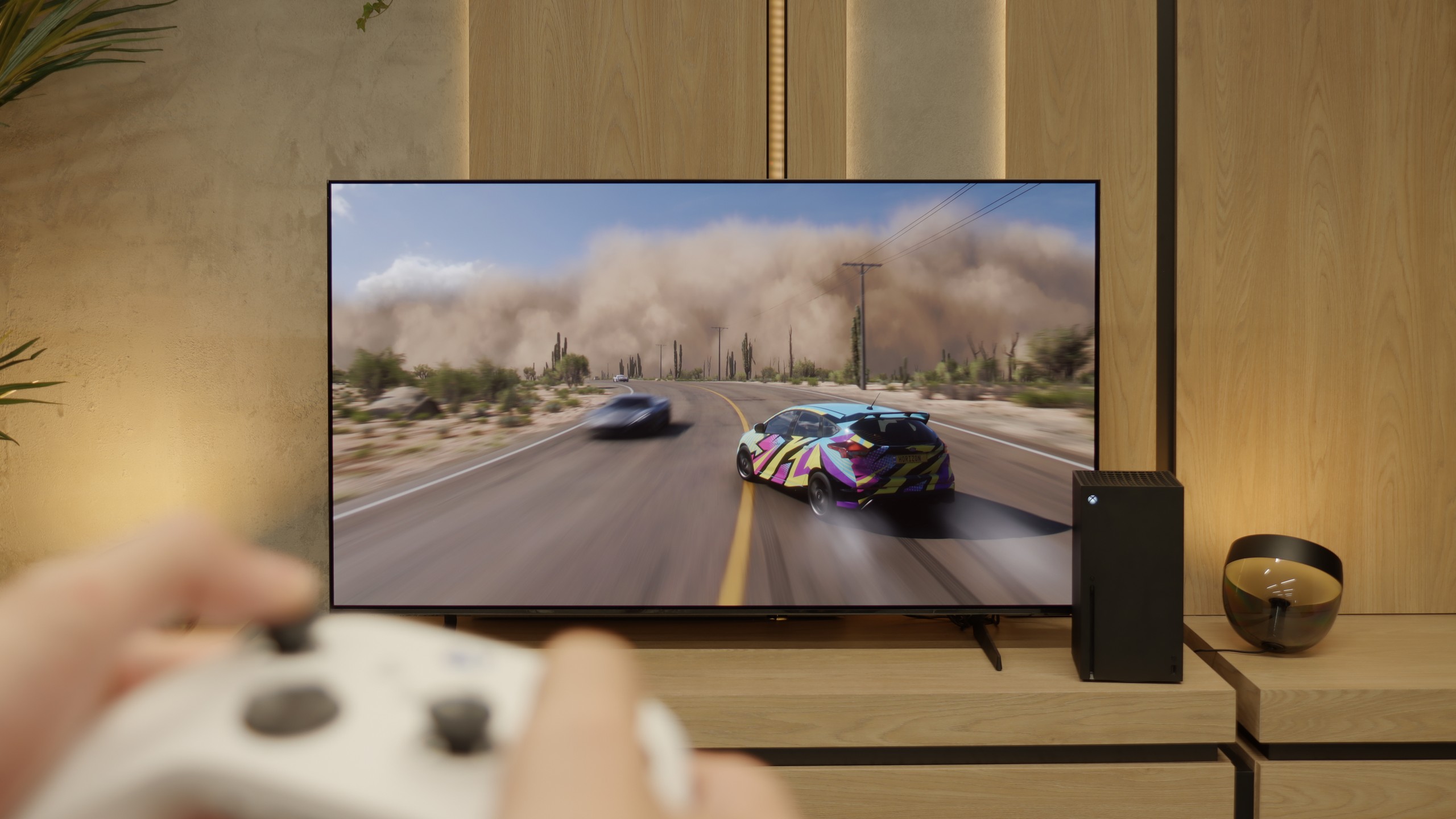
The Philips OLED 809 supports all the technologies included in the HDMI 2.1 standard, and during our tests, each one activated without any problems. Therefore, we must state that this television is perfect for all gamers, both those using a console and a computer. It's worth mentioning that the manufacturer has implemented the HGIG mode, which is a great alternative to Dolby Vision, which unfortunately on the OLED809 is unplayable due to the very high input lag.
A nod to gamers is also the inclusion of a dedicated GameBar, which allows monitoring of current gameplay parameters and quick adjustments of settings. There is also a function to activate a crosshair, which will be very useful when shooting from a sniper rifle, but from the so-called hip. Additionally, we can also find a shadow enhancement function for better visibility in shadows and a colour filter for gamers with visual impairments.
In summary, the OLED 809 is a very good and versatile device for gamers. Anyone who purchases this television for gaming does not need to worry about anything, as it is simply designed for gaming. Especially since features such as VRR, ALLM, G-Sync, FreeSync, and HDR Dolby Vision gameplay will allow for an even deeper immersion in their favourite title. Lastly, we should note that the only downside of the television in game mode is the artificial sharpening of the image, regardless of the settings, and it cannot be 'softened.'
S85F has practically everything on board to become the dream screen for gaming. Four full HDMI 2.1 ports with a bandwidth of 48 Gb/s, support for VRR, ALLM, a super-detailed Game Bar that clearly shows all parameters – plus a gem in the form of Game Motion Plus. This motion smoother makes animation in games more enjoyable, while input lag increases slightly. It's a rare combination, and that’s a big plus for Samsung.
Perhaps Samsung will fix this in the next update – and we have high hopes for that. Because if HGiG comes back, the S85F will become nearly the perfect TV for gamers.
Input lag
9.5/10
10/10
SDR
HDR
Dolby Vision
The results of the input lag measurements on the Philips OLED 809 are at a high level, regardless of the signal or resolution. All gamers will surely appreciate the manufacturer's efforts, thanks to which a game running at 4K120Hz with HDR has only 5 ms of lag, which is practically unnoticeable even in online games. One should not forget about the proper implementation of the game mode with Dolby Vision, which can be praised for a similar response time of 13 ms. In this case, the Philips OLED 809 receives our highest score.
Here, dear gamers, the S85F shows its claws. 5 ms with 120 Hz content and around 10 ms with 60 Hz are results that can be described in one word in the world of televisions – phenomenal. This means that the response to our movements is practically instantaneous. We press the button, and the action on the screen happens without any delay, as if the television can read our thoughts. In dynamic games, where a fraction of a second can decide victory or defeat, such values make a huge difference. There's no question of a nervous "wait" for the image to catch up with our movements. The S85F gives us the feeling that everything is under our complete control – and that's how it should be in equipment that aspires to be the ideal screen for a gamer.
Compatibility with PC
6.4/10
7.6/10

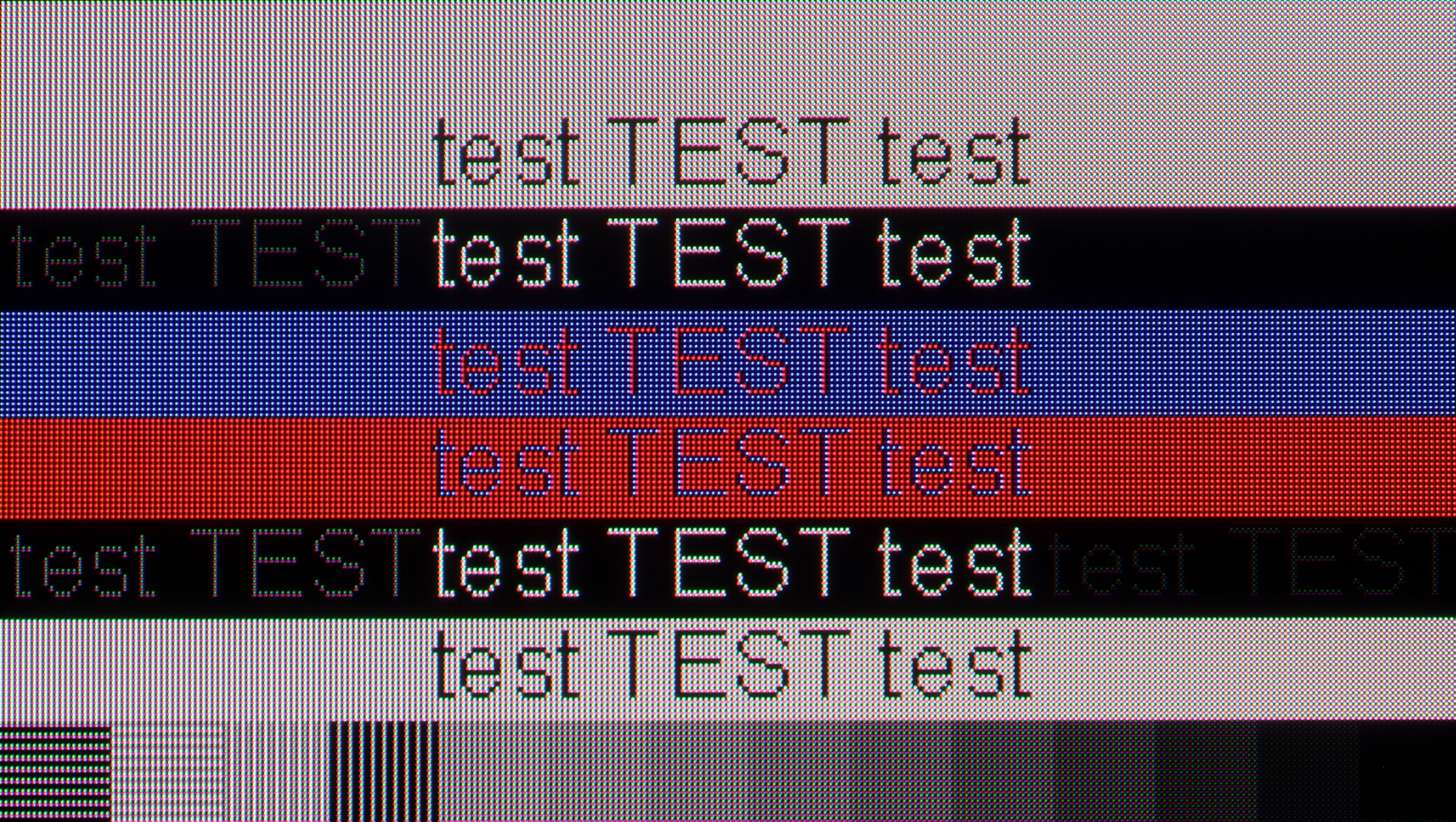
Just like in games, the tested television performs excellently, but when it comes to everyday text work, it doesn't quite measure up. Its latency is very low; however, the issue lies elsewhere. The television does not support chroma 4:4:4, which results in unpleasant font blurriness, regardless of the given refresh rate. While this is not usually a problem in games, it can be quite annoying during text work due to poor readability. Additionally, the pixel layout in WOLED matrices doesn't make things easier for it.
If you're planning to connect the S85F to a computer, we have good news – this television is perfect for that. Low input lag and a 120 Hz panel make gaming on PC a pure pleasure. Whether we're talking about dynamic shooters or more relaxed RPGs, the response is instantaneous, and the smoothness of the animation can draw you in for hours on end.
Of course, there’s no rose without thorns. Due to the diamond pixel layout in the QD-OLED panel, there is a slight "rainbow icon" effect, particularly noticeable when sitting close to the screen. Fortunately, this is more of a detail that most of you won’t mind in everyday use. Especially since, thanks to the proper implementation of 4:4:4 chroma, the readability of fonts is at a very good level – documents, websites, and text editors simply look as they should.
Viewing angles
7.4/10
9.8/10
A widely known advantage of OLED panels is their efficiency when viewed even at sharp angles. There is no noticeable drop in contrast or colour saturation. However, a characteristic feature of panels produced by LG Display, which are not used in top models, is a tint in marine or cyan shades when viewed from a wide angle.
Here, dear readers, the S85F reaches the absolute peak. The viewing angles are phenomenal – some of the best you can get in a TV today, and it’s thanks to the unique QD-OLED panel from Samsung Display. Of course, WOLED panels can also maintain a high level in this regard, but let’s not kid ourselves – what the QD-OLED shows in the S85F is even more impressive. Colours, contrast, and brightness remain practically unchanged even when viewing the screen from a very large angle. It’s the kind of television where you don’t have to fight for the “best spot on the couch” – everyone will see the picture in all its glory, no matter where they’re sitting.
TV efficiency during daytime
5.5/10
5.1/10

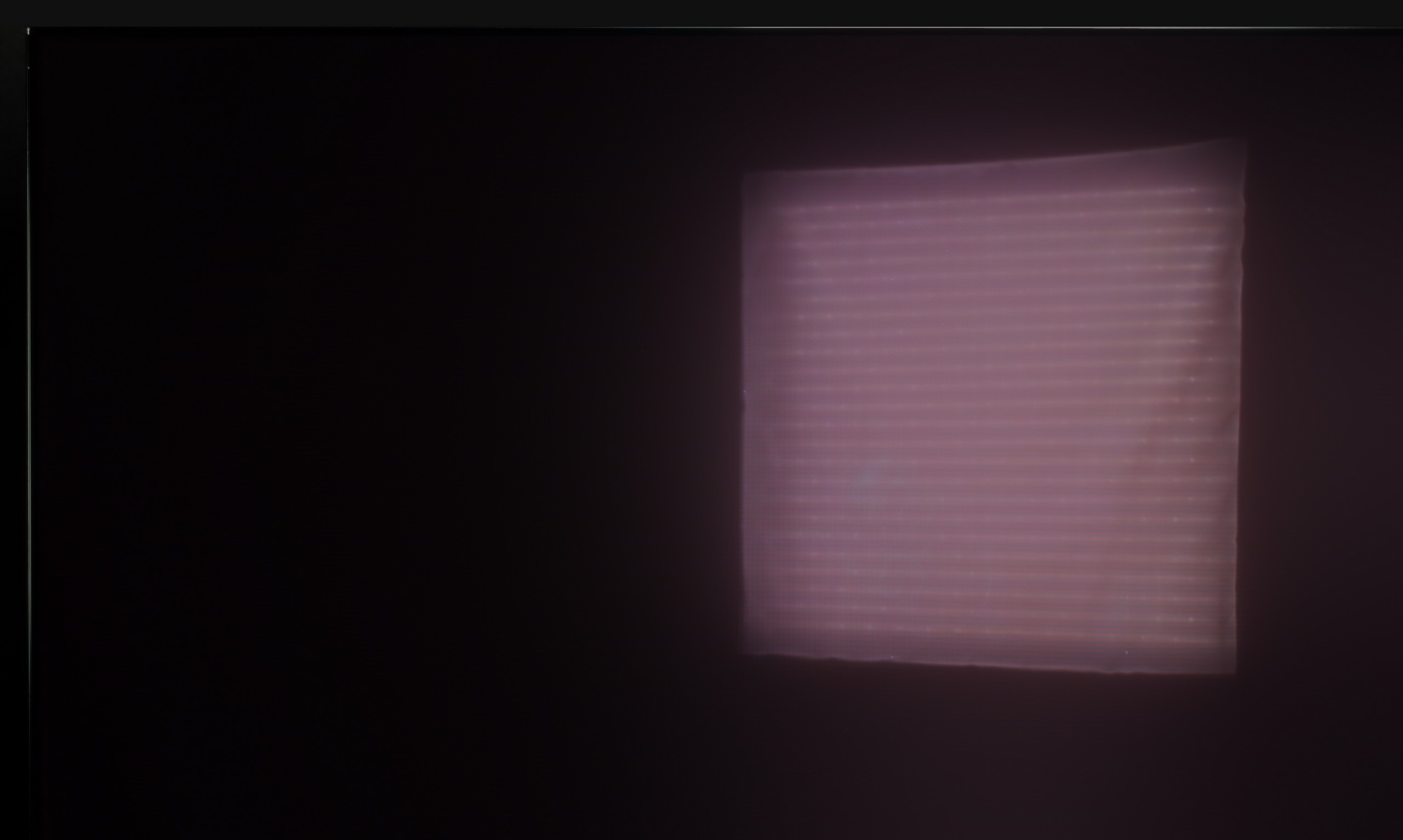


Matrix brightness
Average luminance SDR
Samsung S85F OLED: 317 cd/m2
Philips OLED809/819: 322 cd/m2
For many years, the issue of the performance of OLED TVs during the day has been raised. Many people still believe that these are not receivers intended for such use. They probably have a point, particularly when it comes to screens from several years ago. Technology has advanced, and currently, there are no objections to recommending such a TV for today. Admittedly, a glossy screen doesn't sound like something that would support this claim, however, it's hard to argue against the pictures that you can see for yourself. Another point we would like to highlight is the contrast during daytime use. This, in contrast to QD-OLED panels, and even OLEDs equipped with MLA technology, is higher. This is due to the absence of excited quantum dots and micro-lenses.
We really liked the saying "no rose without thorns," and it fits perfectly with QD-OLED TVs. Especially when we look at their performance in highly lit conditions. As you may notice, under very intense light, the surface of the panel can take on a slightly cherry hue. The effect is subtle in the case of the S85F, but in extreme lighting conditions, black can appear a bit worse than in WOLED panels. But – and this "but" is key here – QD-OLED suppresses direct light reflections much better. This means that reflections will be less bothersome, and the picture will retain clarity even when something bright reflects on the screen. You win some, you lose some.
As for brightness, the S85F is a moderately bright OLED. It’s not a model designed for extremely sunny living rooms. If you plan to place it in a very bright room, we recommend considering blinds or placing it in a location that at least partially protects it from direct light.
Details about the matrix
Subpixel Structure:


Panel uniformity:
Philips OLED809/819
Samsung S85F OLED
TV features
7.8/10
7.2/10
- HDMI inputs2 x HDMI 2.0, 2 x HDMI 2.1 48Gbps0 x HDMI 2.0, 4 x HDMI 2.1 48Gbps
- Other inputsToslink (Optical audio)
- OutputsToslink (Optical audio), eARC (HDMI), ARC (HDMI)Toslink (Optical audio), eARC (HDMI), ARC (HDMI)
- Network InterfacesWi-Fi 2.4GHz, Wi-Fi 5GHz, Ethernet (LAN) 100MbpsWi-Fi 2.4GHz, Wi-Fi 5GHz, Ethernet (LAN) 100Mbps
- TV receptionDVB-T, DVB-T2, DVB-S, DVB-S2, DVB-CDVB-T, DVB-T2, DVB-S, DVB-S2, DVB-C
Classic features:
- Recording to USB (terrestrial TV)
- Recording programming
- Picture in Picture (PiP)
- RF remote control (no need to aim at the screen)
- Backlit remote control
- Teletext
- Audio only mode
- Possibility to connect Bluetooth headphones to the TV
- Possibility to simultaneously use Bluetooth headphones and the TV speaker
Smart features:
- AirPlay
- Screen mirroring (Windows Miracast)
- Wyszukiwanie głosowe
- Voice search in native language
- Ability to connect a keyboard and mouse



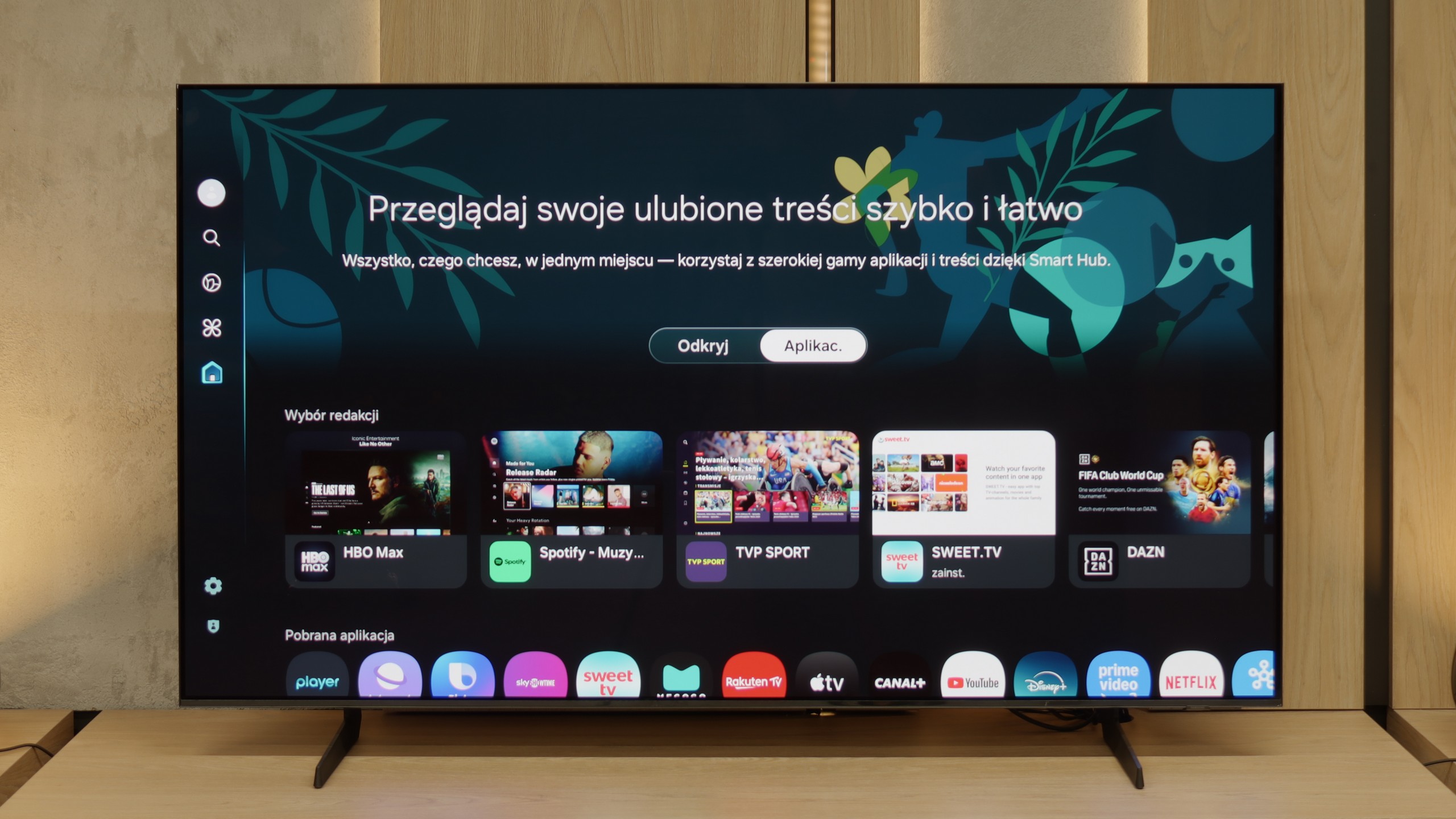
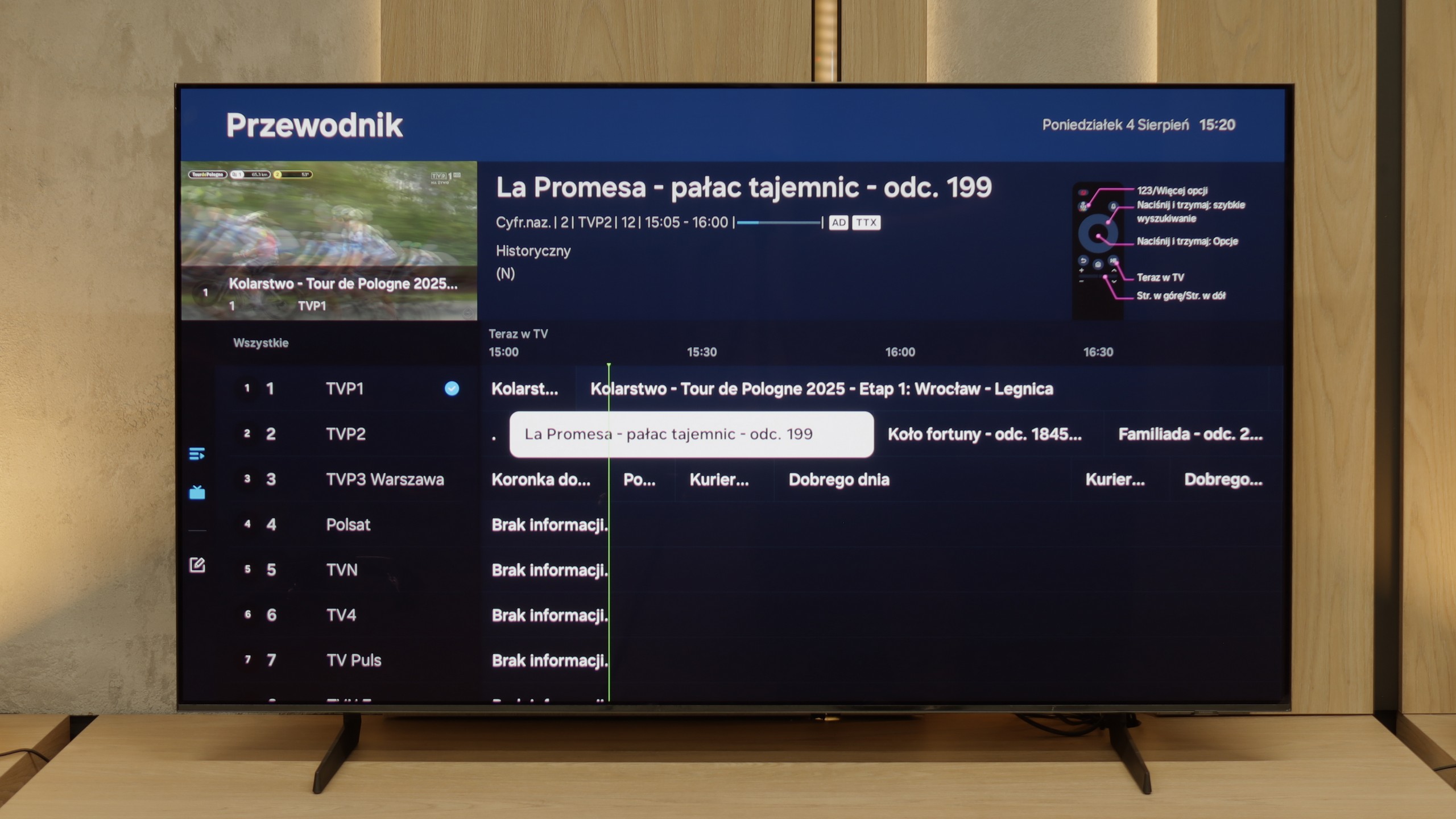
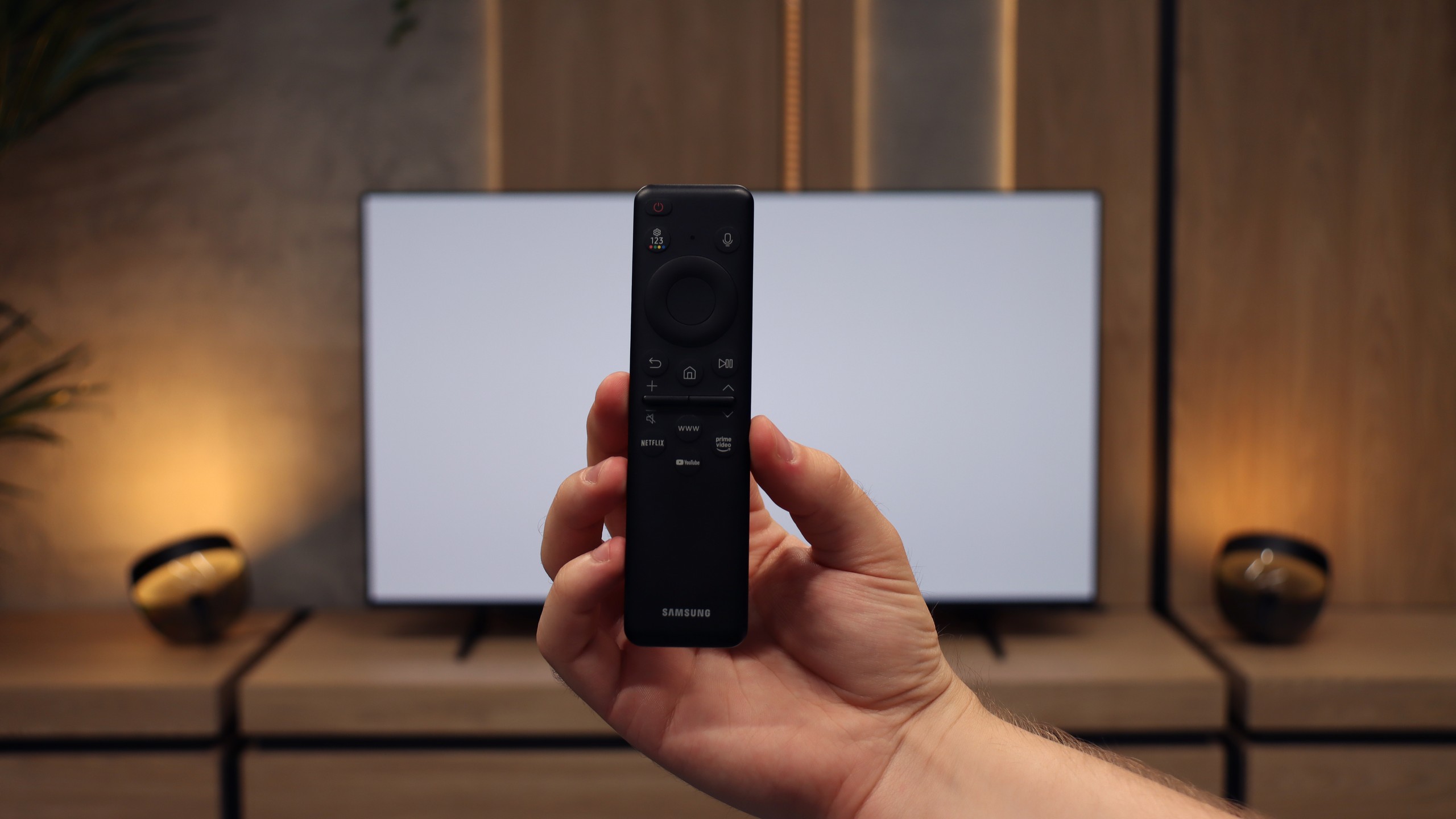

Before we dive into the software that controls the television, it’s impossible not to mention the biggest distinguishing feature of the manufacturer's televisions. This is, of course, the multicoloured Ambilight backlighting, which is located on the back of the device and displays colours tailored to what's happening on the screen, often allowing for an even greater immersive experience. The Philips OLED 809 is powered by the Google TV system. This is an undeniable advantage compared to some other models from the manufacturer, which use the proprietary TitanOS system, significantly more closed off and limited in terms of available applications. With Google TV, we can install practically any application, both from the store and directly from online repositories via an APK file.
The Google TV system also offers many conveniences related to control. We can easily connect a keyboard with a touchpad, which greatly simplifies typing queries and navigation. Additionally, thanks to integration with Google, we can issue voice commands using the remote, which are quickly and accurately interpreted by the system.
In summary: Google TV is currently one of the most popular systems on the market. Thanks to a powerful CPU, it runs very smoothly and stably, without freezing or stuttering during testing. This is definitely the best option for those who want to get the most out of their television's capabilities and appreciate the openness and versatility of the system.
Features of the classic S85F television
The S85F was not really designed with fans of classic television in mind. We won’t find a PiP function here (which is somewhat surprising, as Samsung typically offers it) or the ability to record programs onto USB from the built-in tuners. Fortunately, the basics are there – teletext and a clear channel guide – so it’s more than sufficient for regular, everyday viewing. The included remote, although simple at first glance and lacking a numeric keypad, allows for control of multiple devices. This means that when connecting, for example, a Canal+ decoder, you don’t need two remotes on the table – the one for the television is quite enough.
SmartTV S85F: Tizen
The smart part is a completely different story. Tizen is one of the most comprehensive operating systems in televisions. It operates smoothly, supports all popular internet functions – from screen mirroring to AirPlay to voice search. The strongest point of Tizen is its integration with the SmartThings app, which can act as a control centre for the entire home. Of course, like any closed system, Tizen has its limitations – for instance, a smaller app library compared to GoogleTV. However, looking at the current list of available applications, it’s hard to point out anything that might actually be missing.
Playing files from USB
9.5/10
9.1/10
Supported photo formats:
Maximum photo resolution:

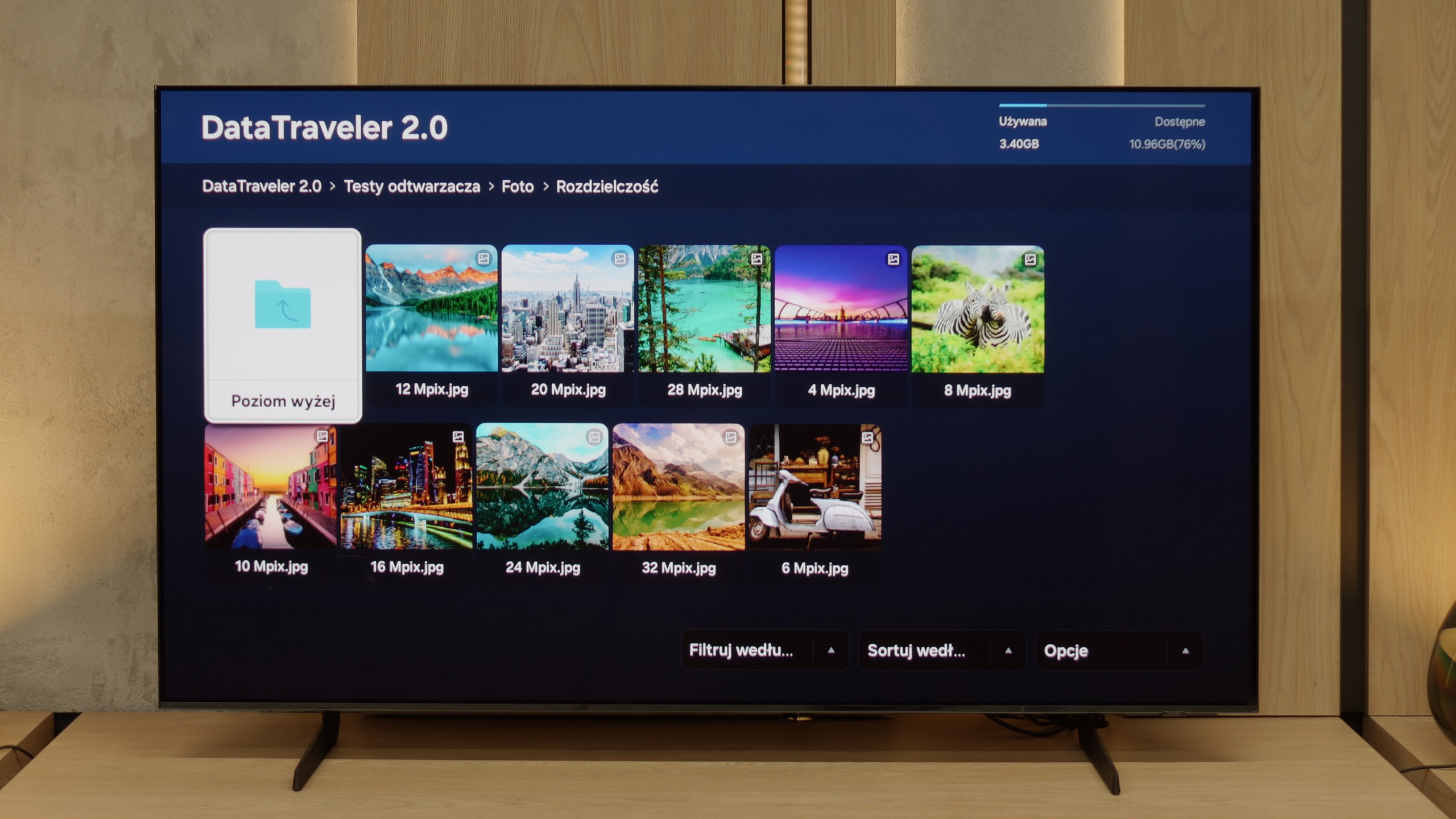
The default file player on the Philips OLED 809 is quite impressive, although it does have some drawbacks. It handles a wide range of video file formats exceptionally well, except for two less common ones. It deserves high praise for its inclusion of all the checkboxes confirming playback of various subtitle formats. The TV can manage any photo resolution, making it an excellent screen for viewing family albums or studio photos. The rest, including supported photo and audio formats, is satisfactory, and those formats the TV cannot play are either uncommon or obsolete. Moreover, it's not a problem, as we can download an app from the app store that will solve these issues.
The built-in media player in the S85F performs excellently – practically everything you throw on a USB stick or hard drive will be played back without the slightest issue. Minor shortcomings only arise in the support of some less common photo formats, but for the vast majority of you, this will be more than sufficient. Therefore, it can be confidently stated that for home use, the built-in player is more than solid.
Apps
9.6/10
8.7/10














































Sound
7.1/10
7.2/10
- Subjective sound quality:7.1/107.2/10
- Dolby Digital Plus 7.1:
- Dolby True HD 7.1:
- Dolby Atmos in Dolby Digital Plus (JOC):
- Dolby Atmos in Dolby True HD:
- DTS:X in DTS-HD MA:
- DTS-HD Master Audio:
At the outset of this paragraph, it should be noted that sound quality is always subjective. In our opinion, the audio system that the manufacturer has equipped the Philips OLED 809 is at quite a high level. The bass is well-defined, but at the same time, it does not overshadow the mid and high tones. Looking at it from another perspective, when choosing a TV in this price range, we are more likely to already have an additional audio system. In this context, the tested television will definitely not disappoint, as it supports practically every important standard, including Dolby Atmos and, more importantly, DTS-HD Master Audio.
The built-in speakers rated at 20 W on paper may not seem impressive, but in practice, the S85F can be surprising. It sounds really pleasant, and at times you can even pick up a subtle bass, which is not a given in this class of speakers. The TV does not support the DTS format, which unfortunately became a standard for most manufacturers by 2025. A nice surprise is the support for Dolby Atmos. Of course, talking about "spatial" sound with two speakers located at the bottom of the casing would be a slight exaggeration, but it's good that Samsung offers such a feature in this model at all.


